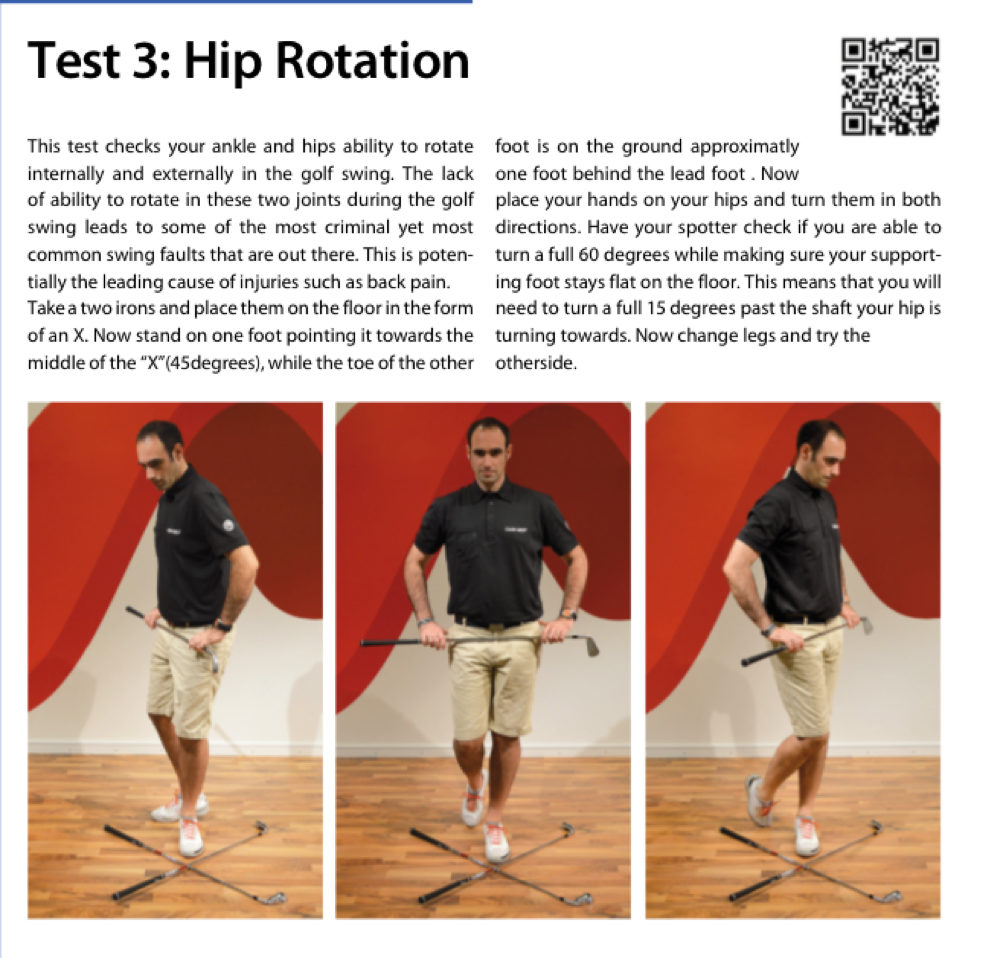Improve your hip movement so you can swing and feel better
“If you have a body then you are an athlete!” – Bill Bowerman
I love this quote from Bill Bowerman, a track-and-field coach who was a co-founder of Nike, because of its simplicity. It’s a reminder to golfers that no matter their shape, weight, age or golfing ability, they are without a doubt an athlete.
If we agree that everyone is an athlete, it makes sense that to improve athletic performance, golfers need to do what they can to remove physical limitations from their game. The good news is that the simplest of activities that you do on a daily basis are athletic movements. Everything from getting up in the morning, to making a cup of coffee, drinking the coffee to sitting on the toilet are all athletic movements and require functional movement. To perform them, your body needs to work together as a unit in order to function efficiently on a daily basis. Your brain needs to communicate to your central nervous system, which in turn needs to communicate to the correct muscles and activate them in the correct firing sequence to achieve the task at hand. So in this sense, movement is athleticism. The more complicated the task, the more athletic ability is required; the less complicated the task, the less athletic ability is required. This is what Bowerman meant when he said, “If you have a body then you are an athlete.”
The golf swing is a complicated athletic movement that demands a whole lot from your body every time you set up to the ball and swing the club. It’s powerful, explosive and you will need a descent amount of athletic ability to make an efficient golf swing. So it all comes down to you as an individual, and how athletically your body can or can’t move that will determine how efficiently you can make a golf swing.
Here’s the Kicker
It never ceases to amaze me how many people go around with physical limitations on a daily basis, and are completely unaware that they have these hidden problems that prevent them from moving more athletically. Unfortunately, having limitations forces golfers to compensate from moving athletically and functionally.  Not only do they lead to poor ball striking, but usually at some point down the road pop up in the form of an injury due to overworked muscles compensating for faulty movement patterns. More often than not, injuries occur not where the limitations are, but in the joints that are placed above or below the dysfunctional area.
Not only do they lead to poor ball striking, but usually at some point down the road pop up in the form of an injury due to overworked muscles compensating for faulty movement patterns. More often than not, injuries occur not where the limitations are, but in the joints that are placed above or below the dysfunctional area.
Take the lower back, for example. It’s one of the more common areas that plague golfers with pain, and believe me, this has nothing to do with your age either. Statistics say that 80 percent of people in their 20’s have suffered from lower back pain. One of the culprits for lower back pain is lack of hip mobility. In the golf swing, if your hips aren’t able to turn efficiently, then you will be forced to compensate in your swing. It puts a ton of added stress on the joints that are both above the hips, the lower back, or below the hips, the knees.
So it’s up to you. If you want a more efficient golf swing that can produce penetrating drives straight down the middle of the fairway and past your playing partners ball, or you’d just like to remove that nagging slice while at the same time have no more pain, why not start by overhauling your body so that it can move more athletically?
Here’s How
First of all, you’ll need to take a physical assessment, and by this I DO NOT mean you’ll need to bend over and cough twice!
PHHEEW…. No, I mean you’ll need to visit a golf Medical or Fitness expert, you can find one here. They can make a simple physical assessment of you to check and see how well your joints and muscles can move. If you have any limitations, then they’ll give you some simple exercises that can help get you straightened out and on the right path to improving your golf performance and your quality of life as an added bonus.
Watch this video as I walk you through some exercises and tests that will get your hips moving efficiently so that you can make a more athletic movement in your golf swing. Also, I’ve added a test with correctional exercises directly from my book Golfers Handbook – Save your golf game and your LIFE below that you can try at home.
Instruction
The Wedge Guy: Beating the yips into submission

There may be no more painful affliction in golf than the “yips” – those uncontrollable and maddening little nervous twitches that prevent you from making a decent stroke on short putts. If you’ve never had them, consider yourself very fortunate (or possibly just very young). But I can assure you that when your most treacherous and feared golf shot is not the 195 yard approach over water with a quartering headwind…not the extra tight fairway with water left and sand right…not the soft bunker shot to a downhill pin with water on the other side…No, when your most feared shot is the remaining 2- 4-foot putt after hitting a great approach, recovery or lag putt, it makes the game almost painful.
And I’ve been fighting the yips (again) for a while now. It’s a recurring nightmare that has haunted me most of my adult life. I even had the yips when I was in my 20s, but I’ve beat them into submission off and on most of my adult life. But just recently, that nasty virus came to life once again. My lag putting has been very good, but when I get over one of those “you should make this” length putts, the entire nervous system seems to go haywire. I make great practice strokes, and then the most pitiful short-stroke or jab at the ball you can imagine. Sheesh.
But I’m a traditionalist, and do not look toward the long putter, belly putter, cross-hand, claw or other variation as the solution. My approach is to beat those damn yips into submission some other way. Here’s what I’m doing that is working pretty well, and I offer it to all of you who might have a similar affliction on the greens.
When you are over a short putt, forget the practice strokes…you want your natural eye-hand coordination to be unhindered by mechanics. Address your putt and take a good look at the hole, and back to the putter to ensure good alignment. Lighten your right hand grip on the putter and make sure that only the fingertips are in contact with the grip, to prevent you from getting to tight.
Then, take a long, long look at the hole to fill your entire mind and senses with the target. When you bring your head/eyes back to the ball, try to make a smooth, immediate move right into your backstroke — not even a second pause — and then let your hands and putter track right back together right back to where you were looking — the HOLE! Seeing the putter make contact with the ball, preferably even the forward edge of the ball – the side near the hole.
For me, this is working, but I am asking all of you to chime in with your own “home remedies” for the most aggravating and senseless of all golf maladies. It never hurts to have more to fall back on!
Instruction
Looking for a good golf instructor? Use this checklist

Over the last couple of decades, golf has become much more science-based. We measure swing speed, smash factor, angle of attack, strokes gained, and many other metrics that can really help golfers improve. But I often wonder if the advancement of golf’s “hard” sciences comes at the expense of the “soft” sciences.
Take, for example, golf instruction. Good golf instruction requires understanding swing mechanics and ball flight. But let’s take that as a given for PGA instructors. The other factors that make an instructor effective can be evaluated by social science, rather than launch monitors.
If you are a recreational golfer looking for a golf instructor, here are my top three points to consider.
1. Cultural mindset
What is “cultural mindset? To social scientists, it means whether a culture of genius or a culture of learning exists. In a golf instruction context, that may mean whether the teacher communicates a message that golf ability is something innate (you either have it or you don’t), or whether golf ability is something that can be learned. You want the latter!
It may sound obvious to suggest that you find a golf instructor who thinks you can improve, but my research suggests that it isn’t a given. In a large sample study of golf instructors, I found that when it came to recreational golfers, there was a wide range of belief systems. Some instructors strongly believed recreational golfers could improve through lessons. while others strongly believed they could not. And those beliefs manifested in the instructor’s feedback given to a student and the culture created for players.
2. Coping and self-modeling can beat role-modeling
Swing analysis technology is often preloaded with swings of PGA and LPGA Tour players. The swings of elite players are intended to be used for comparative purposes with golfers taking lessons. What social science tells us is that for novice and non-expert golfers, comparing swings to tour professionals can have the opposite effect of that intended. If you fit into the novice or non-expert category of golfer, you will learn more and be more motivated to change if you see yourself making a ‘better’ swing (self-modeling) or seeing your swing compared to a similar other (a coping model). Stay away from instructors who want to compare your swing with that of a tour player.
3. Learning theory basics
It is not a sexy selling point, but learning is a process, and that process is incremental – particularly for recreational adult players. Social science helps us understand this element of golf instruction. A good instructor will take learning slowly. He or she will give you just about enough information that challenges you, but is still manageable. The artful instructor will take time to decide what that one or two learning points are before jumping in to make full-scale swing changes. If the instructor moves too fast, you will probably leave the lesson with an arm’s length of swing thoughts and not really know which to focus on.
As an instructor, I develop a priority list of changes I want to make in a player’s technique. We then patiently and gradually work through that list. Beware of instructors who give you more than you can chew.
So if you are in the market for golf instruction, I encourage you to look beyond the X’s and O’s to find the right match!
Instruction
What Lottie Woad’s stunning debut win teaches every golfer

Most pros take months, even years, to win their first tournament. Lottie Woad needed exactly four days.
The 21-year-old from Surrey shot 21-under 267 at Dundonald Links to win the ISPS Handa Women’s Scottish Open by three shots — in her very first event as a professional. She’s only the third player in LPGA history to accomplish this feat, joining Rose Zhang (2023) and Beverly Hanson (1951).
But here’s what caught my attention as a coach: Woad didn’t win through miraculous putting or bombing 300-yard drives. She won through relentless precision and unshakeable composure. After watching her performance unfold, I’m convinced every golfer — from weekend warriors to scratch players — can steal pages from her playbook.
Precision Beats Power (And It’s Not Even Close)
Forget the driving contests. Woad proved that finding greens matters more than finding distance.
What Woad did:
• Hit it straight, hit it solid, give yourself chances
• Aimed for the fat parts of greens instead of chasing pins
• Let her putting do the talking after hitting safe targets
• As she said, “Everyone was chasing me today, and managed to maintain the lead and played really nicely down the stretch and hit a lot of good shots”
Why most golfers mess this up:
• They see a pin tucked behind a bunker and grab one more club to “go right at it”
• Distance becomes more important than accuracy
• They try to be heroic instead of smart
ACTION ITEM: For your next 10 rounds, aim for the center of every green regardless of pin position. Track your greens in regulation and watch your scores drop before your swing changes.
The Putter That Stayed Cool Under Fire
Woad started the final round two shots clear and immediately applied pressure with birdies at the 2nd and 3rd holes. When South Korea’s Hyo Joo Kim mounted a charge and reached 20-under with a birdie at the 14th, Woad didn’t panic.
How she responded to pressure:
• Fired back with consecutive birdies at the 13th and 14th
• Watched Kim stumble with back-to-back bogeys
• Capped it with her fifth birdie of the day at the par-5 18th
• Stayed patient when others pressed, pressed when others cracked
What amateurs do wrong:
• Get conservative when they should be aggressive
• Try to force magic when steady play would win
• Panic when someone else makes a move
ACTION ITEM: Practice your 3-6 foot putts for 15 minutes after every range session. Woad’s putting wasn’t spectacular—it was reliable. Make the putts you should make.
Course Management 101: Play Your Game, Not the Course’s Game
Woad admitted she couldn’t see many scoreboards during the final round, but it didn’t matter. She stuck to her game plan regardless of what others were doing.
Her mental approach:
• Focused on her process, not the competition
• Drew on past pressure situations (Augusta National Women’s Amateur win)
• As she said, “That was the biggest tournament I played in at the time and was kind of my big win. So definitely felt the pressure of it more there, and I felt like all those experiences helped me with this”
Her physical execution:
• 270-yard drives (nothing flashy)
• Methodical iron play
• Steady putting
• Everything effective, nothing spectacular
ACTION ITEM: Create a yardage book for your home course. Know your distances to every pin, every hazard, every landing area. Stick to your plan no matter what your playing partners are doing.
Mental Toughness Isn’t Born, It’s Built
The most impressive part of Woad’s win? She genuinely didn’t expect it: “I definitely wasn’t expecting to win my first event as a pro, but I knew I was playing well, and I was hoping to contend.”
Her winning mindset:
• Didn’t put winning pressure on herself
• Focused on playing well and contending
• Made winning a byproduct of a good process
• Built confidence through recent experiences:
- Won the Women’s Irish Open as an amateur
- Missed a playoff by one shot at the Evian Championship
- Each experience prepared her for the next
What this means for you:
• Stop trying to shoot career rounds every time you tee up
• Focus on executing your pre-shot routine
• Commit to every shot
• Stay present in the moment
ACTION ITEM: Before each round, set process goals instead of score goals. Example: “I will take three practice swings before every shot” or “I will pick a specific target for every shot.” Let your score be the result, not the focus.
The Real Lesson
Woad collected $300,000 for her first professional victory, but the real prize was proving that fundamentals still work at golf’s highest level. She didn’t reinvent the game — she simply executed the basics better than everyone else that week.
The fundamentals that won:
• Hit more fairways
• Find more greens
• Make the putts you should make
• Stay patient under pressure
That’s something every golfer can do, regardless of handicap. Lottie Woad just showed us it’s still the winning formula.
FINAL ACTION ITEM: Pick one of the four action items above and commit to it for the next month. Master one fundamental before moving to the next. That’s how champions are built.
PGA Professional Brendon Elliott is an award-winning coach and golf writer. You can check out his writing work and learn more about him by visiting BEAGOLFER.golf and OneMoreRollGolf.com. Also, check out “The Starter” on RG.org each Monday.
Editor’s note: Brendon shares his nearly 30 years of experience in the game with GolfWRX readers through his ongoing tip series. He looks forward to providing valuable insights and advice to help golfers improve their game. Stay tuned for more Tips!











Randy
Jun 5, 2016 at 12:34 pm
The video link in the last paragraph is still set to private.
Golfshapeforelife
Jun 3, 2016 at 8:12 am
Good exercise. I have coached Track & Field (We call it Athletics here in the UK), and have been a Sprinter/Jumper myself and find that simple walkover/stepover drills over low-level barriers (such as two upturned range ball buckets with a shaft laid across) work fine. Anyone can do a fire hydrant and a few trail leg drills, these open up the hips very well
Adam Stevenson
Jun 3, 2016 at 9:02 am
Golfshapeforelife, thank you for your response. You’re right, walkover/stepover with buckets and shafts sounds like a great way to loosen up those hips as well. Getting those hips to move better is a crucial key in getting your athletes to move better.
Cr
Jun 2, 2016 at 6:37 pm
This only helps a little bit, when I can’t load and twist on my ankle like some supple people. My ankle is rigid and just wants to get out of the way so I break my left knee and twist out my foot as it rotates with the leg and hip. If I could keep it planted the hips would also need to be supple.
Adam Stevenson
Jun 3, 2016 at 3:01 am
Cr, it sounds like this exercise is perfect for you. Though you will need to do it several times a week as a correctional exercise for your lack of suppleness in your ankles and hips. You should be able to see measurable results relatively shortly though I would highly recommend you search for someone that can assist you on this link http://www.mytpi.com/experts
Best of luck and if you have any questions please mail me: adamstevensongolf@mail.com
Cr
Jun 5, 2016 at 2:02 pm
Yaaaa. never gonna happen. I’d have to swing like Bubba or Reed with every club and get my lead foot out of the way, I just can’t post on it and twist like Adam Scott with feminine joints like a gymnast
golfraven
Jun 2, 2016 at 4:02 pm
Not sure if this may help me much, although the excercise is challenging. Opened the video and thought my phone was hijacked because of the flashy intro.
Adam Stevenson
Jun 3, 2016 at 3:10 am
Thanks for your response golfraven, if this exercise is challenging for you then I would highly recommend you continue to use it. There are most likely reasons that it is challenging and if you challenge yourself to master this movement then you will see improvement. 🙂
Best of luck and if you have any further questions please contact me adamstevensongolf@mail.com
JR
Jun 1, 2016 at 9:05 pm
The video link in the last paragraph is set to private
Adam Stevenson
Jun 3, 2016 at 3:01 am
Thank you JR